
Please click on the image and refer to the image metadata page for copyright and licensing information.
Non-seed plant groups
- +----Liverworts
- |
- --+ +-----Mosses
- | |
- +---+ +-----Club
mosses, whisk ferns(?)
- | |
-
+---+ +-----Horsetails
-
| +---+
-
+---+ +-----Ferns
-
|
-
+-----------Seed plants (gymnosperms, angiosperms)
Division Hepatophyta (Liverworts)

Liverworts are found in very moist habitats, such as along rocky
streams. |
 |

Closeups of liverwort gametophytes. |
 |

Some species of liverworts can reproduce asexually through gemmi, which
form in cup shaped structures on the gametophytes. |
|
Division Bryophyta (Mosses)

Polytrichum
juniperinum (juniper polytrichum moss). The green, leafy gametophyte is the familiar "moss" we see in
moist environments. It has no vascular system and therefore cannot
grow higher than a few cm. |

The sporophyte grows from its top of its parental gametophyte and is
dependent on it for nutrition. The capsule atop the long stalk
contains spores. |
Division Psilophyta (whisk ferns)
Psilotum nudum (whisk fern)

The non-photosynthetic gametophyte lives underground and derives
nutrition from mycorrhizal fungi. |
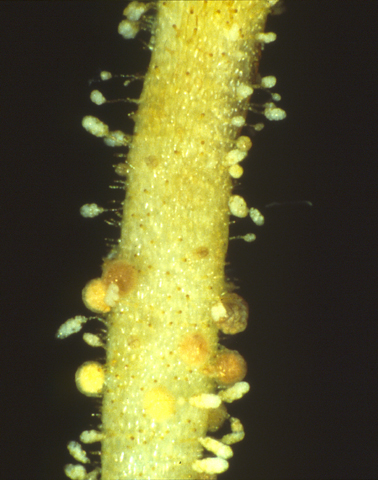
Microscopic view of gametophyte. The protrusions on the surface
are gemmae, antheridia, and archegonia. |

Image of plants collected from soil. The horizontal plant with
bumps (antheridia) is the gametophyte. The y-shaped plant behind it
is the developing rhyzome of a very young sporophyte offspring of the
gametophyte. |

The sporophyte is one of the simplest vascular plants and has no
roots. |

Psilotum has tiny scales for leaves. |

The sporangia are located in the upper part of the stems. |
Division Lycopodiophyta
Class Lycopodiopsida (clubmosses)

Lycopodiella
alopecuroides (foxtail clubmoss) - This gametophyte is
photosynthetic, but only a few mm in size. |

The sporophyte is beginning to develop out of the gametophyte of this
Lycopodium sp. |
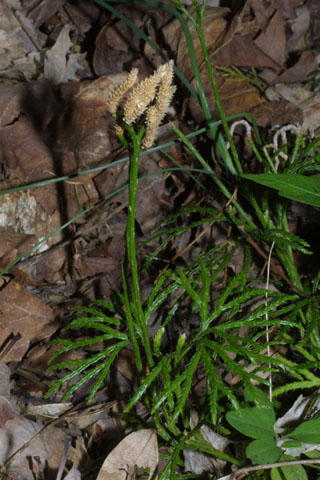
Lycopodium
digitatum (fan clubmoss) - Clubmoss sporophytes are among the
simplest vascular plants. |

Lycopodium
digitatum (fan clubmoss) - In some species, sporangia are located in strobili (cones) at the tips of the leafy stems, or at the top of
long stalks (hence the name "club"). |
Class Isoetopsida (spikemoss and quillworts)
Selaginella species

Sporophyte |

"Cones" containing sproangia. Selaginella
produces two different types of spores: megaspores that develop into
female gametophytes and microspores that develop into male
gametophytes. The gametophytes may begin development within the
cone before they are shot violently out of the cone to begin an
independent existance. |
Division Equisetophyta (horsetails)
Equisetum
hyemale
var. affine (scouring rush horsetail)
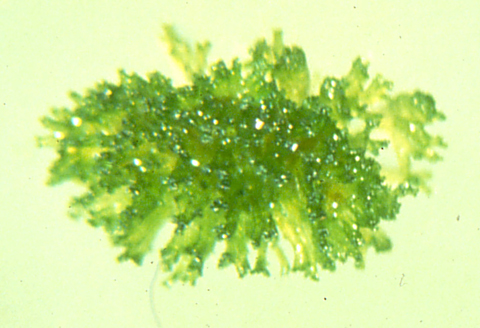
The Equisetum gametophyte is small (about 4 mm long) and
photosynthetic. |
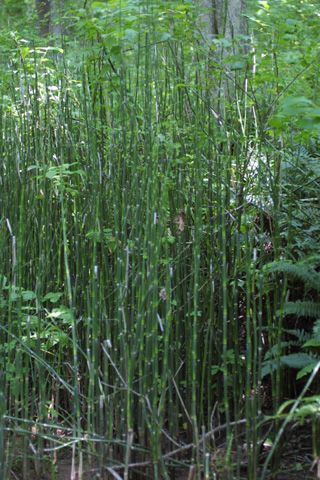
Equisetum sporophytes may be found in wet areas. Silica in
the tough stems makes them suitable for scrubbing pots - hence the name
"scouring rush". |
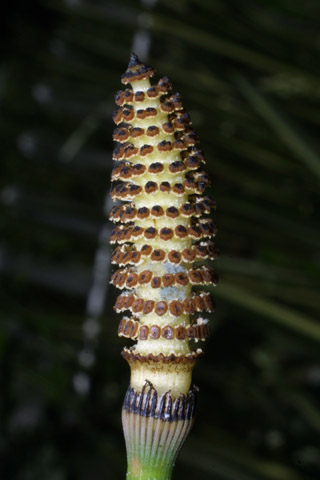
Spore-bearing stroboli (cones) are
located at the top of the stems. |

Leaves in this species are small and arranged in whorls around the
stem. Most photosynthesis occurs in the stem.
|
Division Polypodiophyta (ferns)
Order Ophioglossales (adder's tongue ferns)
Botrychium
dissectum (cutleaf grapefern)

The gametophyte is tiny (a few mm long) and non-photosynthetic. It
lives underground and is parasitic on mycorrhizal fungi. Here
is another non-photosynthetic gametophyte,
and another. |

The sporophyte has photosynthetic leaves. |

Sporangia are borne on a spike that rises above the plant. |
|
Order Polypodiales (various ferns)
Ceratopteris richardii (triangle waterfern). Spores
commercially available as "C-ferns".

C. richardii produces two sexes of gametophytes. This is a
microscopic view of a hermaphrodyte (having both male and female
reproductive structures). |

This is a male C. richardii gametophyte. (Males are
actually smaller than females. This male is photographed at a higher
magnification than the hermaphrodyte at the left.) |

This is a male at higher magnification, showing sperm (corkscrew-shaped)
that have been released when the gametophyte was exposed to water. |

Closeup of sperm under phase contrast. |

After fertilization, the zygote develops into a sporophyte which grows
on top of the gametophyte. The developing sporophyte is seen here as
a small green "tongue" growing in the middle of the hermaphrodyte. |

This is the full-grown sporophyte. |



































